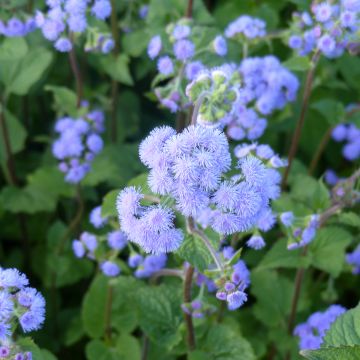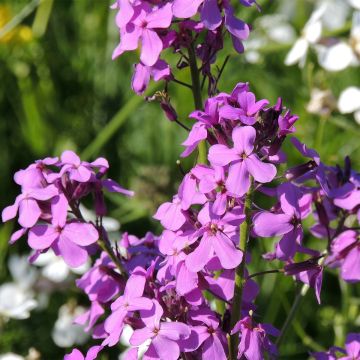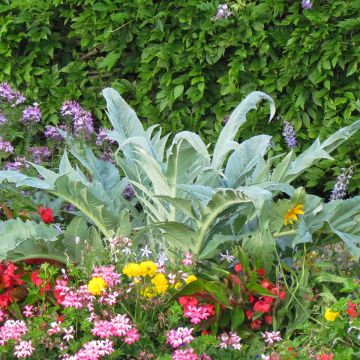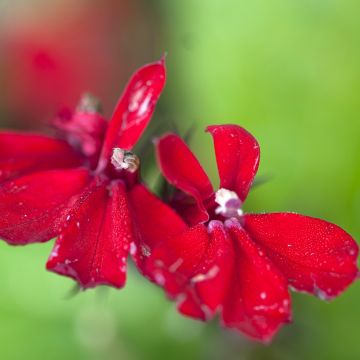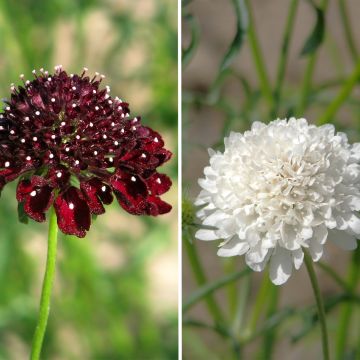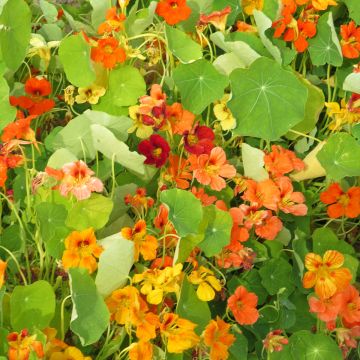

Dipsacus sylvestris - Cardère sauvage


Dipsacus sylvestris - Cardère sauvage
Dipsacus fullonum - Wild Teasel seeds
Dipsacus fullonum
Wild Teasel, Fuller's Teasel, common teasel
Nothing to say, it's about seeds but I enjoyed your magnificent catalogue. Thank you.
Monique H., 01/08/2018
Special offer!
Receive a €20 voucher for any order over €90 (excluding delivery costs, credit notes, and plastic-free options)!
1- Add your favorite plants to your cart.
2- Once you have reached €90, confirm your order (you can even choose the delivery date!).
3- As soon as your order is shipped, you will receive an email containing your voucher code, valid for 3 months (90 days).
Your voucher is unique and can only be used once, for any order with a minimum value of €20, excluding delivery costs.
Can be combined with other current offers, non-divisible and non-refundable.
Home or relay delivery (depending on size and destination)
Schedule delivery date,
and select date in basket
This plant carries a 6 months recovery warranty
More information
We guarantee the quality of our plants for a full growing cycle, and will replace at our expense any plant that fails to recover under normal climatic and planting conditions.
Would this plant suit my garden?
Set up your Plantfit profile →
Description
Dipsacus sylvestris, also known as Common Teasel, Fuller's Teasel, or Field Teasel, is a wild plant that can easily reach an impressive size during flowering, in its second year. It displays upright flower heads in June-July, resembling spiky brushes, with small pinkish-purple flowers gradually blooming and emerging from bracts which remain long after flowering. The unique structure of its leaves is capable of retaining rainwater in small cups, where some birds come to drink. This undemanding plant, once so useful to humans, deserves a special place in a wild garden, a meadow bed, or as dried or fresh cut flowers.
The Common Teasel is native to North Africa, Europe, and Western Asia. This plant from the Dispacaceae family naturally grows in moist soils in ditches and riverbanks. In the first year, it forms a basal rosette of long pointed leaves that curl up when the plant flowers. This prickly plant can sometimes reach a height of 1.80 m (6ft). In the second year after sowing, at the end of solid leafy stems, it has flower heads about 8 cm (3in) long, upright on long pedicels. They bloom into pinkish-purple florets emerging from incurved and flexible bracts that are very durable, even after flowering. The rough, opposite leaves with spiny midribs, grouped in pairs along the flower stem are fused at the base to form cups where water accumulates. The true function of these cups is still under study, but it seems that teasels are capable of absorbing dissolved or suspended mineral substances, similar to some carnivorous plants. Goldfinches in particular like the ripe seeds, which they help disperse.
Sow teasels in wild beds and meadows, alongside other thistles or tall perennials like hybrid mulleins or Cephalaria gigantea. This plant will thrive near water and help to stabilise the banks.
Etymology: 'Dipsacus' is derived from the Greek Dipsan akeomaï = "I quench thirst." In Latin, Sylvestris = "wild, of the woods"; Fullonum = "fuller." A cultivated variety of teasel with elongated heads and downward-curved tips, Dipsacus sativus, was used in the wool industry for hand-finishing woollen fabrics.
Report an error about the product description
Flowering
Foliage
Plant habit
Botanical data
Dipsacus
fullonum
Dipsacaceae
Wild Teasel, Fuller's Teasel, common teasel
West Asia
Other Thompson and Morgan seeds
View all →Planting and care
Sow teasel seeds in March-April, on carefully weeded and hoed, bare soil. Bury the seeds lightly by pressing and raking the soil, as you would for radish or lettuce seeds. Water carefully to avoid disturbing the seeds. Keep the area moist. As the seedlings emerge, thin out to keep only one young plant every 40 to 50 cm (16 to 20in). Teasels need plenty of sunlight to thrive. They grow best in deep, fertile, even clayey soil.
Sowing period
Intended location
-
, onOrder confirmed
Reply from on Promesse de fleurs
Haven't found what you were looking for?
Hardiness is the lowest winter temperature a plant can endure without suffering serious damage or even dying. However, hardiness is affected by location (a sheltered area, such as a patio), protection (winter cover) and soil type (hardiness is improved by well-drained soil).

Photo Sharing Terms & Conditions
In order to encourage gardeners to interact and share their experiences, Promesse de fleurs offers various media enabling content to be uploaded onto its Site - in particular via the ‘Photo sharing’ module.
The User agrees to refrain from:
- Posting any content that is illegal, prejudicial, insulting, racist, inciteful to hatred, revisionist, contrary to public decency, that infringes on privacy or on the privacy rights of third parties, in particular the publicity rights of persons and goods, intellectual property rights, or the right to privacy.
- Submitting content on behalf of a third party;
- Impersonate the identity of a third party and/or publish any personal information about a third party;
In general, the User undertakes to refrain from any unethical behaviour.
All Content (in particular text, comments, files, images, photos, videos, creative works, etc.), which may be subject to property or intellectual property rights, image or other private rights, shall remain the property of the User, subject to the limited rights granted by the terms of the licence granted by Promesse de fleurs as stated below. Users are at liberty to publish or not to publish such Content on the Site, notably via the ‘Photo Sharing’ facility, and accept that this Content shall be made public and freely accessible, notably on the Internet.
Users further acknowledge, undertake to have ,and guarantee that they hold all necessary rights and permissions to publish such material on the Site, in particular with regard to the legislation in force pertaining to any privacy, property, intellectual property, image, or contractual rights, or rights of any other nature. By publishing such Content on the Site, Users acknowledge accepting full liability as publishers of the Content within the meaning of the law, and grant Promesse de fleurs, free of charge, an inclusive, worldwide licence for the said Content for the entire duration of its publication, including all reproduction, representation, up/downloading, displaying, performing, transmission, and storage rights.
Users also grant permission for their name to be linked to the Content and accept that this link may not always be made available.
By engaging in posting material, Users consent to their Content becoming automatically accessible on the Internet, in particular on other sites and/or blogs and/or web pages of the Promesse de fleurs site, including in particular social pages and the Promesse de fleurs catalogue.
Users may secure the removal of entrusted content free of charge by issuing a simple request via our contact form.
The flowering period indicated on our website applies to countries and regions located in USDA zone 8 (France, the United Kingdom, Ireland, the Netherlands, etc.)
It will vary according to where you live:
- In zones 9 to 10 (Italy, Spain, Greece, etc.), flowering will occur about 2 to 4 weeks earlier.
- In zones 6 to 7 (Germany, Poland, Slovenia, and lower mountainous regions), flowering will be delayed by 2 to 3 weeks.
- In zone 5 (Central Europe, Scandinavia), blooming will be delayed by 3 to 5 weeks.
In temperate climates, pruning of spring-flowering shrubs (forsythia, spireas, etc.) should be done just after flowering.
Pruning of summer-flowering shrubs (Indian Lilac, Perovskia, etc.) can be done in winter or spring.
In cold regions as well as with frost-sensitive plants, avoid pruning too early when severe frosts may still occur.
The planting period indicated on our website applies to countries and regions located in USDA zone 8 (France, United Kingdom, Ireland, Netherlands).
It will vary according to where you live:
- In Mediterranean zones (Marseille, Madrid, Milan, etc.), autumn and winter are the best planting periods.
- In continental zones (Strasbourg, Munich, Vienna, etc.), delay planting by 2 to 3 weeks in spring and bring it forward by 2 to 4 weeks in autumn.
- In mountainous regions (the Alps, Pyrenees, Carpathians, etc.), it is best to plant in late spring (May-June) or late summer (August-September).
The harvesting period indicated on our website applies to countries and regions in USDA zone 8 (France, England, Ireland, the Netherlands).
In colder areas (Scandinavia, Poland, Austria...) fruit and vegetable harvests are likely to be delayed by 3-4 weeks.
In warmer areas (Italy, Spain, Greece, etc.), harvesting will probably take place earlier, depending on weather conditions.
The sowing periods indicated on our website apply to countries and regions within USDA Zone 8 (France, UK, Ireland, Netherlands).
In colder areas (Scandinavia, Poland, Austria...), delay any outdoor sowing by 3-4 weeks, or sow under glass.
In warmer climes (Italy, Spain, Greece, etc.), bring outdoor sowing forward by a few weeks.






























